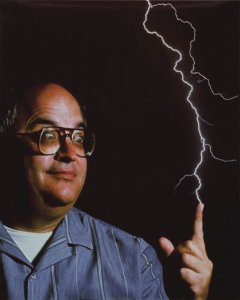Pioneers of the National Lightning Detection Network
The evolution of modern lightning-detection follows years of innovations in sensing technology and cooperation with industry and government labs. Its birth and commercialization, however, begins with two lightning scientists, Drs. E. Philip Krider (left) and Martin Uman. When they met at the University of Arizona in the late 1960s, their interest drove them to develop the first gated, wide band, magnetic direction finders for locating lightning ground strokes. These pinpointed a location and strength and were linked into the first large-area detection networks in 1976. Krider and Uman formed Lightning Location Protection (LLP) Inc. with first customers the Bureau of Land Management (BLM), the National Severe Storms Laboratory (NSSL), and the State University of N.Y. at Albany (SUNYA). Each formed regional networks for detecting wildland fires and meteorological research.
In the early ‘80s, East Coast utilities were beginning to use the lightning data from SUNYA network to track storms, and with support from the Electric Power Research Institute (EPRI), develop more accurate maps of lightning area density.
Dr. Richard Orville (lower mid) a lightning expert at SUNYA, envisioned how regional lightning networks could be formed to help track storms across the U.S. In 1987, he led a team to develop such capability using satellites to retrieve and process lightning data from sensors over large areas. The team joined the networks formed by SUNYA, BLM, and NSSL into one network that
covered the continental U.S.
In 1990, Drs. Kenneth Cummins (lower rt) and Alburt Pifer (not pictured) guided sensor improvements for better location accuracy and detection efficiency. Cummins guided software development to help utilities apply statistical analyses of lightning activity to locate future facilities, compare line faults to lightning activity, and more. He has advanced the science of lightning using modern signal processing techniques.
Cummins, a Research Professor in Arizona, focuses on the physics of lightning and electromagnetic sensing. The National Lightning Detection Network, now owned and operated by Vaisala, continues to support research by the wind industry to better understand how lightning interacts with wind turbines and how to protect that infrastructure during thunderstorms.
Filed Under: Innovators & influencers, News








